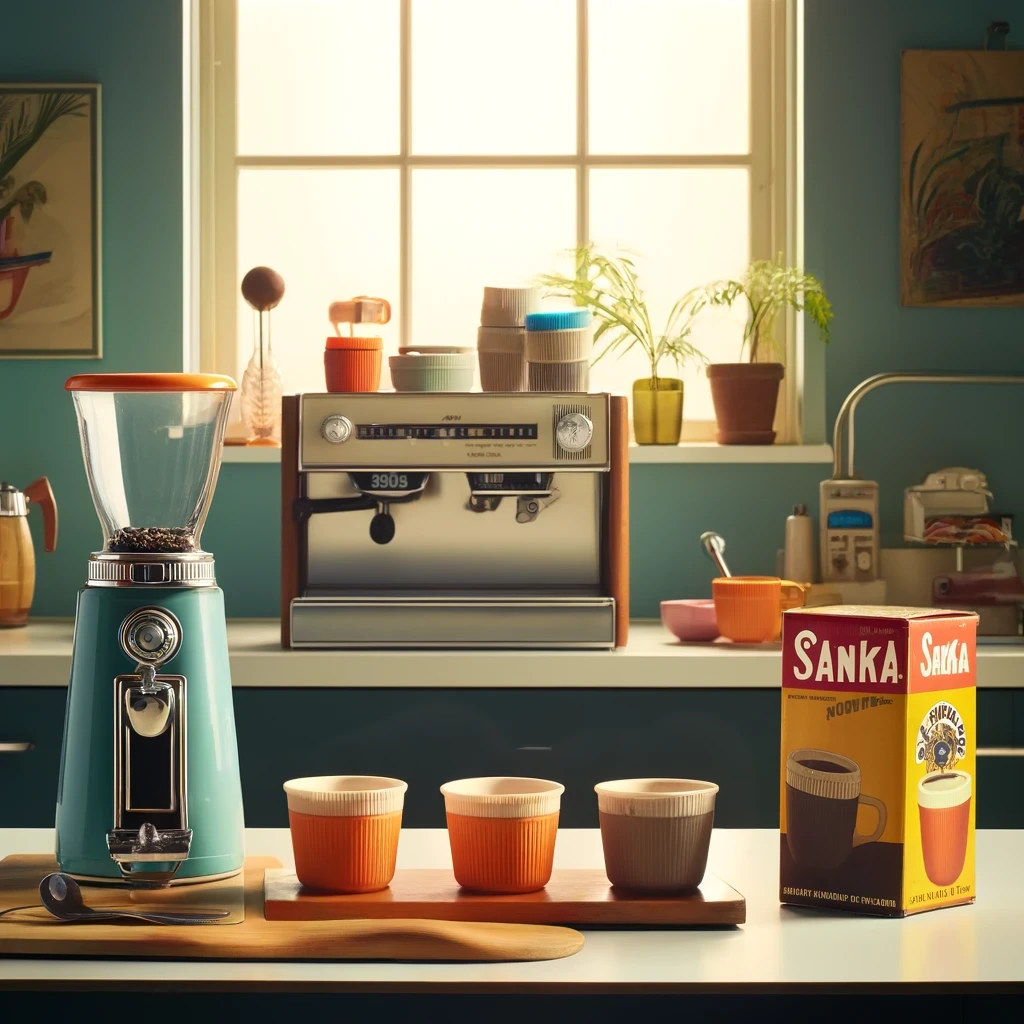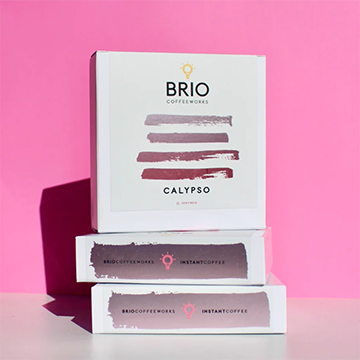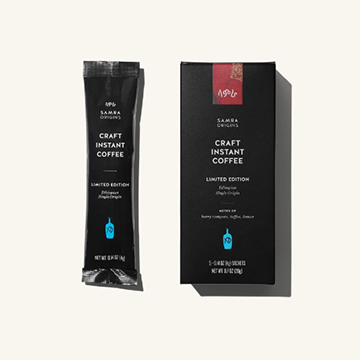Best Instant Coffees for the Hybrid Work Experience
AI interpreting the very first cup of coffee I ever drank.
By: Tim Cynova // Published: April 12, 2024
The first cup of coffee I ever had was Sanka. I was six years old and still remember those sips vividly… as well as heaping spoonfuls of powdered creamer into the cup in hopes of improving the awful taste. Was it my unfamiliarity with coffee or was it Sanka? Probably both.
Fast forward several decades to when I worked in an office with eight different ways of making coffee — drip, Keurig, AeroPress, siphon, single-cup pour over, Chemex, French Press (3 cup), French Press (8 cup). We even had a group of coworkers who would gather every day at 3:30PM to engage in an incredibly precise coffee making process using their own fancy beans. If you wandered through the kitchen at just the right time you might even score their extra cup of coffee. That office had such a strong coffee culture – and, to be fair, a burgeoning tea contingent – our talented coworker even illustrated a “12 Days of Coffee” e-book as a year-end offering to share with our members.
After riding the Third Wave and that office’s coffee fanciness, my senses were slightly better calibrated than in those early Sanka days. So, you might imagine my skepticism when I encountered craft coffee shops selling their roasts in single serve instant coffee packets. (I mean, I knew Starbucks was pushing instant with their Via line but, never being a big fan of Starbucks, I dismissed it as a non-starter.) It was with that *healthy* dose of skepticism that I bought a few boxes from craft roasters, conducted side-by-side taste tests using the same roasters’ regular beans and the same roast in instant, and quickly became a convert. Did the cups taste identical? No. Did I mind it once I discovered new use cases for the instant variety? Not at all.
Planes to Trains, Campfires to Conference Calls ✈️ 🚂 🔥 💻
Making a cup of pour-over coffee for me is an often meditative experience. A rare moment of calm and focus in frequently uncertain and hectic days. I also find that because of limited time in the day or due to my travel schedule, the traditional pour-over process isn’t always possible. Once I tossed a few instant packets into my bag a whole new world of better tasting coffee began to unfold. And with it, a faster yet still meditative moment in my day.
A few of the places where instant coffee started to change my coffee game:
Asking for a cup of hot water on planes and mixing my own craft brew.
Using the hotel room coffee machine to heat up water and mixing in a pack of instant.
Camping coffee? Sure, you know, if camping is your thing.
I occasionally use an instant packet as an emergency cup of coffee in the morning to power me to the *actual* coffee shop. (Sometimes you need coffee to go get coffee.)
When time between Zoom meetings is too tight for the slower brewing process. Instant to the rescue!
As my colleague Katrina and I were facilitating search committee meetings, an impromptu coffee break with instant packets came in handy to keep the group focused during our post-lunch interviews. It was there I learned from another colleague about the myriad Japanese varieties that are now on my list to explore.
After realizing the regional nature of many craft instant coffees, my colleagues from across the U.S. and Canada started bringing them to use as trading cards of sorts when we gather for in-person meetings. We each bring a box or two from various local roasters and then share them to create mix-and-match batches to take home. Also part of a coffee-loving crew? Consider adding this to your next in-person staff gathering, or even a conference add-on. It’s kind of like when people go to the Olympics and trade pins with fellow spectators from around the world, or so I’ve heard.
The Brew in My Queue: What’s Currently Percolating in My Cup ☕
As with anything that comes in multiple varieties, part of the fun here is trying different brands and roasts. Below are some that I’ve tried and keep in regular rotation. First, a technical note. Instants come in two grind varieties: coarse crystals and a fine powder. I’ve found that the fine powder sometimes hardens in the packet, requiring a bit more work to avoid ending up with coffee sludge in the bottom of your cup. The challenge here is that the coffees made using the fine powder method often are more flavorful and interesting to me. For that reason, if I’m buying the packets in person, I sometimes open the box to check that the packets haven’t hardened.
A terrific coffee roaster located in Burlington, Vermont with three different roasts to explore – Calypso, Guatemala, and Ethiopia Ardi. You can also often order the same roasts in whole bean to conduct your own side-by-side taste tests.
Offers a veritable rabbit hole of great roasts with their 12 different instant varieties. They even offer some favorites in larger form packaging. Occasionally you can locate Verve at stores like Whole Foods.
I like to toss different Partners roasts into the rotation every now and then. If you live near one of their physical stores, you can sometimes find different varieties than what might currently be available on their website. They also offer a decaf option.
This one is new in my mix and is a limited edition offering. So, I imagine at some point soon I’ll be sad that I didn’t stock up on more of these packets before the run ends. (The Samra shouldn’t be confused with Blue Bottle’s Instant Espresso that I personally find to be *way* too salty.)
While Mount Hagen probably won’t win any major awards, it’s (1) relatively easy to find, (2) won’t break the bank, and (3) makes a better than average cup of coffee. If it’s going to be a multiple cup of coffee day, I don’t hesitate to make it with Mount Hagen (then my heart immediately wonders why I didn’t go with the above Partners decaf). To be fair, Mount Hagen also makes a decaf option.
When discussing instant coffees with my colleague Nico, they reminded me that our former coworker at the aforementioned eight-ways-to-make-coffee workplace raved about the magic of Cafe Bustelo. I’m including it here as homage to that office crew and, like Mount Hagen, it’s relatively easy to find and less expensive than many other instant varieties. (I guess, come to think of it, we had nine ways of making coffee in that office.)
Once I began mentioning that I was writing a piece about craft instant coffees, people started sharing their favorites with me. Full disclosure, I’ve yet to try Swift’s line, but it came so highly recommended from a coffee lover that I’m including it here.
Not ready to make the leap to instant just yet?
A few coffee roasters are making their brews available in single serving pour over packaging.
The original pocket pour over brand splits the difference, if you will, between your home set-up and instant packets. You can choose from 6 different roasts, and know that you’re also supporting people and the planet while enjoying your morning coffee. The expandable pour over is a bit more work intensive than instant packets – I definitely wouldn’t attempt it on a plane – but it offers a bit more of the classic pour over experience in a portable package that’s starting to be replicated by various other roasters.
Dripkit offers individually packaged pour overs from a variety of different roasters including Le Colombe, Stumptown, La Pacifica, Rival Bros, and more. And, if you’re a fan of coffee subscription services, Dripkit even offers an avenue for that exploration.
If you’re more of a coffee making “gearhead,” the Pourigami might be something to add to your stable of equipment. It’s more work intensive than an instant packet or all-in-one pocket pour over, but it’s a cool low-profile design for easier packing and portability.
What does all of this have to do with the workplace?
Well, besides the obvious, of course: That people in the U.S. alone drink hundreds of millions of cups of coffee each day while working?
Don’t Let Perfect Be the Enemy of Good (Enough)
There’s a concept called the 85% Rule. Simply put, aiming for 85% in efforts can prevent burnout but maintain high standards without demanding perfection. In other words, don’t let perfect be the enemy of good (enough).
Sometimes the time and energy it takes us to complete the remaining 15% of a project isn’t worth those resources. 85% is more often than not good enough. Few people even notice – or care about – the additional “value” of that 15%, especially if the alternative is 0%. We can see this in instant coffee, right? Is it 100% of its original, no. But in the use cases above instant’s 85% is often lightyears beyond the alternative, and takes less time and energy. It’s good enough.
Coffee and the “Solved Problem”
A great cup of coffee — and the ways it’s made — could be considered a “solved problem.” We had so many solved problems in the workplace circa January 2020. We knew how to move money, how to hire, how to communicate and coordinate projects when everyone was physically in the same space; we knew how to [fill in the blank of a policy, practice, procedure that was “just done that way”].
Then, seemingly overnight, most workplaces could no longer rely on the solved approaches. We were forced to experiment, iterate, and adjust. We had to ask “What If?” and “How might we?” It was in this exploration that we discovered countless other ways of approaching previously solved problems. Approaches that some thought were previously impossible (“Virtual conferences, impossible!” “Great tasting instant coffee, never!”), but they were certainly good enough in the absence of the original thing, and in many ways *better* for more people. We discovered approaches that were more resilient, that were more aligned with the values we hold today than when the processes and procedures were created. It prompted us to pause — many for the first time — to ask “why exactly do we do it this way again?” and “what would happen if we tried a different approach?” Or even “What would happen if we just *didn’t* do that?”
To previously solved problems we discovered new and different ways of going about our work. Some were Sanka quality — no need to try that again, not even spoonfuls of powdered creamer can improve it. Others were craft brew quality. Ah, so vibrant and opens up a range of new possibilities; even leaves time and energy for other things!
Crafting Coffee & Crafting Org Design
The craft of coffee and the craft of organizational design require a similar balance of “solved problems” and innovation, experimentation, and iteration. And even an application of the 85% “good enough” rule.
Just as a simple packet of instant coffee can pivot from my original image of it — Sanka is just the way instant is done — to become a craft item worthy of a connoisseur’s consideration, organizational design too can take its dusty frameworks, pause, and reimagine how they can evolve and adapt into dynamic systems that allow more people to thrive.
Try out a few of the above brews. And when you tear open a packet, consider where in the robust world of work – and workplace design – that it’s capable of change, of reimagining “solved problems” to (re)center values-aligned approaches that create meaningful experiences. Where can we dial it back to 85% and actually open up other opportunities? And if none of this resonates, maybe we can just agree that if work shouldn't suck — why should our (instant) coffee?
Want to explore ways to iterate on solved problems?
Check out our online Quick Courses and Epic Explores.
The courses include everything from how to reimagine your recruitment and hiring process, to creating distributed leadership and decision making models, to introducing race-based affinity groups. You can quickly get up-to-speed on easier ways to scope roles than traditional job descriptions, and consider if creating a Core Curriculum would aim your onboarding process. BONUS: These courses pair well with craft instant coffee!
Tim Cynova is an HR and org design consultant, an educator and podcaster dedicated to dusty off workplaces to (re)center values-based approaches where more people can thrive. He is a certified Senior Professional in HR (SPHR), trained mediator, principal at Work Shouldn’t Suck, on faculty at New York’s The New School, Minneapolis College of Art & Design, and Hollyhock Leadership Institute. He has held executive leadership roles in a variety of nonprofits for the better part of the last 20 years, and is also an avid coffee drinker.











